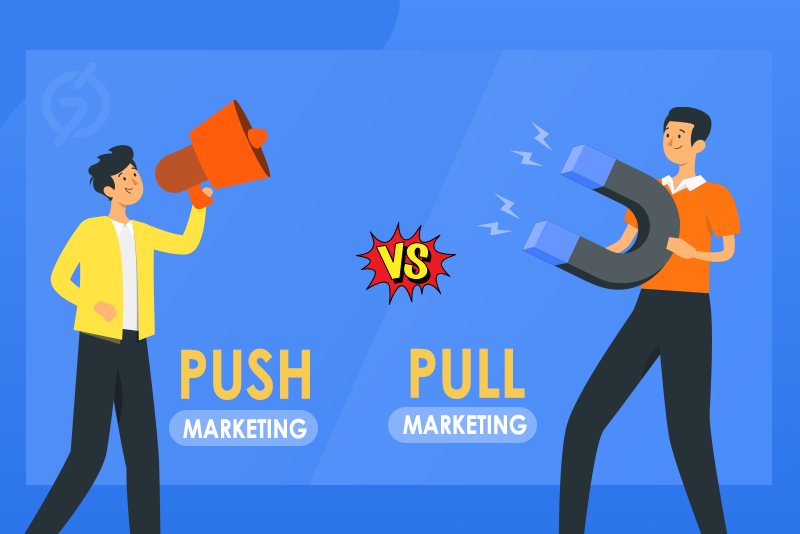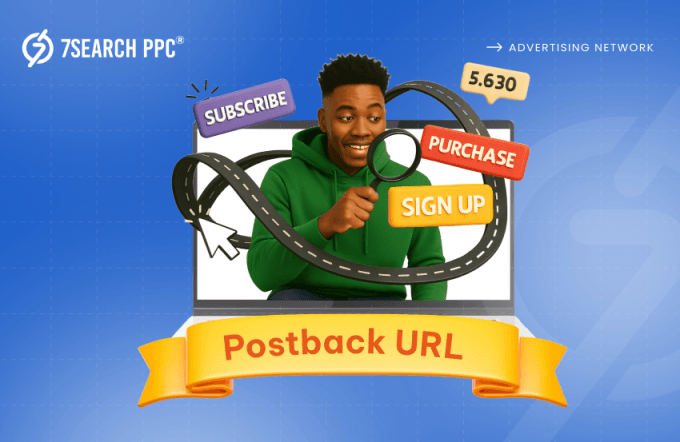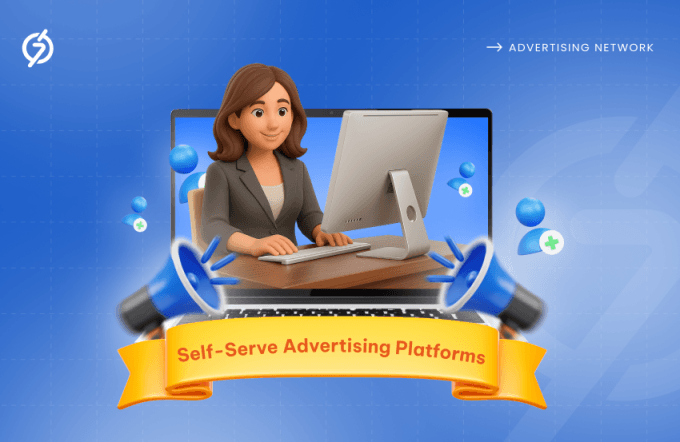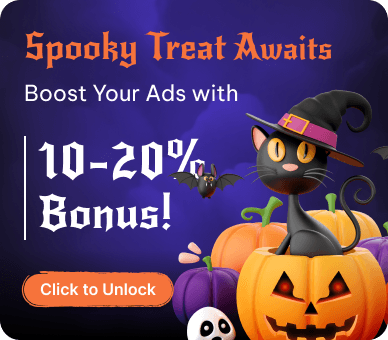My old mobile phone had a major issue that frustrated me most of the time. It would overheat when I charged it and often hung when I played the game “PUBG.” I decided that it was time to change the phone. When I decided to buy a new smartphone, I first saw online ads and read positive reviews, which made me interested in specific brands. This interest “pulled” me towards certain models, or you can say that pulled marketing played its role very well.
Then, I went to the store to look at the phones and talk to the store owner and salesperson. This visit “pushed” me to make my final choice by seeing the phones in person and getting more information.
This example shows how pull and push marketing works both on its own and together to help people make buying decisions. These marketing tactics have one common goal, which is to influence consumer decisions and drive sales effectively. However, their persuasive nature is different.
In this blog, we will discuss the real differences and use of push and pull marketing that will help you better understand how to effectively employ these strategies to drive sales.
Pull Marketing: A Powerful Magnet for Marketers
Suppose you feel thirsty and want to drink a cold drink or beverage. You go shopping with two or three brand names in mind. You go to the shop and ask for the refreshing drink of your choice. You get your drink and enjoy its satisfying taste. Now, the point is, why did you choose those two or three brand names over another alternative? The answer is because of pull marketing, these brands successfully build their brand awareness and convey the value of their products to you.
Pull, or inbound marketing focuses on attracting customers to you rather than pushing your product onto them. It’s like creating a magnet that draws in potential customers with valuable content and experiences. This could involve creating informative blog posts, engaging social media content, or showing consistent brand messaging.
What’s the goal?
The goal is to educate and entice the audience to learn more about your brand and offerings, ultimately leading them to seek you out. Pull marketing builds trust and fosters long-term relationships with potential customers.
The Advantages of Pull Marketing
Pull or inbound marketing offers several advantages for marketers. Some of them are provided below:
- Higher Quality Leads: Pull marketing attracts customers who are already interested in what you offer, unlike push marketing, which sends messages to a broad audience. This is because you create content or use tactics that resonate with their existing needs and search queries. When they reach out, they are more qualified leads, increasing the chances of conversions.
- Increased Brand Visibility and Awareness: Do you know the two factors that play a behind-the-scenes role in making a sale transaction successful? From the consumer’s perspective, two critical factors that contribute to a successful sale transaction are need and information; from the business’s perspective, it’s the visibility and awareness of the brand.
Pull marketing strategies like SEO, content marketing, and paid ads help you make your brand visible, and customers are aware of your brand when they look for something relevant to your offerings. These marketing strategies allow you to provide valuable information or engaging content that people find interesting and informative.
- Enhanced Customer Engagement: This marketing strategy provides an opportunity for a two-way conversation with your ideal audience. By creating interactive content, responding to comments, and addressing questions on social media, you can easily build relationships and trust with your audience. This continuous engagement also enables you to test a product’s acceptance in the market and gather consumer feedback on the existing, newly launched, or upcoming product.
- Minimized Wasted Resources: Pull marketing, by its nature, focuses on drawing in prospective customers who are already intrigued by the product or service being offered. This targeted approach minimizes wasted resources that would otherwise be spent on broad ad campaigns or outbound sales efforts. Instead of paying for reach that may not convert, businesses invest in creating valuable content and optimizing their online presence to naturally attract qualified leads.
Over time, this method tends to be more cost-effective as it nurtures genuine interest and builds a loyal customer base, reducing the need for continuous high-cost advertising expenditures.
- Reduces the Pressure of Conducting Outbound Marketing: Research suggests that customers who visit your online store on their own are more likely to make a purchase compared to those who are pushed. Pull marketing reduces the pressure of outbound marketing from the marketers. Instead of chasing potential customers, you attract them with valuable content and engaging experiences. This permits your sales team to concentrate on generating qualified leads through pull marketing efforts instead of spending time on push marketing tactics that require direct outreach efforts.
What is Push Marketing?
It is essential for you to understand the meaning of push marketing before we differentiate between push and pull strategies for you. Push marketing is the proactive promotion of a product or service to ideal customers, aiming to create demand and generate interest through digital advertising and sales techniques. This contrasts with pull marketing, where a business creates content or uses other strategies to attract customers who are already interested in what they offer. Common push marketing techniques include:
- PPC Advertising
- Email Marketing
- Social Media Ads
Key Aspects of Push Marketing
Here is a breakdown of key aspects:
Goals:
- Increase brand awareness, especially for new products.
- Drive sales by reminding consumers of existing products.
- Influence buying decisions at the moment of sale.
Channels:
- Digital Marketing: Display Advertising, Social Media Advertising, Search Engine Marketing (SEM), Email Marketing.
- Traditional Media: TV Commercials, Radio Ads, Print Ads (magazines, newspapers).
- Public Relations: Press Releases, Media Events, Sponsorships.
- Direct Marketing: Telemarketing, Cold Calls, Brochures.
- Sales Promotions: Discounts, Coupons, Free Trials, Contests.
Advantages:
- Immediate Exposure: Push marketing enables you to quickly reach a large audience with your message. This is especially advantageous for new product launches or time-sensitive promotions, as it can create quick interest and engagement.
- Targeted Reach: With push marketing, you can aim your message at specific groups of people based on their demographics, locations, and behaviors. This helps ensure that your brand’s message reaches the appropriate audience, increasing the chance of converting them into customers.
- Measurable Results: Push marketing campaigns often come with analytics and tracking capabilities. It lets you see how well your campaigns are doing in real-time, make necessary adjustments, and improve your marketing efforts for better outcomes.
- Increased Sales Opportunities: Push marketing creates more chances for sales by regularly showing products or services to potential customers. Frequent reminders and promotions keep the brand visible and encourage people to buy.
How to Use Pull Marketing Strategy
Using a pull or inbound marketing strategy effectively involves attracting customers to your product or service by creating valuable and relevant content that draws them in naturally. Here are some key points on how to implement a pull marketing strategy.
Create High-Quality Content
You must focus on creating high-quality and informative content that addresses the needs, desires, and interests of your ideal audience. This can include blog posts, videos, infographics, ebooks, and social media posts. You must ensure that the content is well-researched, valuable, and tailored to solving problems or answering questions that your audience might have.
Optimize for SEO
Make sure to use SEO best practices to boost your content’s visibility on search engines. Use relevant keywords, create compelling meta descriptions, and ensure your website is technically sound. By attaining a higher rank in search results, you can attract and gain organic traffic from users actively looking for information related to your offerings.
Use Social Media Platforms
There are more than 5.07 billion users active on social media platforms worldwide (combining all the leading platforms). Use social media to share your content and connect with your audience. Make sure to post regularly on leading social media platforms where your ideal audience is active, such as:
You can connect with your followers by replying to their comments, joining conversations, and sharing content they create (in case you love the content). This helps you build relationships and attract social media traffic to your website.
Implement Content Distribution Strategies
Spread your content through various reliable channels to reach a wider audience. This can include:
- Guest posting on other reputable websites
- Collaborating with influencers
- Utilizing content syndication networks.
By getting your content in front of more people, you can increase the chances of attracting potential customers.
How to Use Push Marketing Strategy
If you lean towards the push marketing strategy, don’t worry! We’ve also researched how to effectively utilize push marketing strategies. Please take a look:
Filter Your Audience
It all starts with analyzing your ideal audience. You should define your ideal customer profile, taking into account their age, demographics, interests, and online behavior. This will help you customize your push marketing efforts for maximum impact.
Channel Selection for Advertising
As we all know, traditional methods are not as effective as digital methods. It also costs more, so it does not make sense to consider them for push marketing. With your ideal audience in mind, choose the channels where they spend their time, or you can target them precisely. This could be:
- Ad networks
- Social Media Platforms
Crafting the Message
Create engaging and effective messaging to resonate with your ideal audience. Highlight the advantages of your product or service and address their pain points. Keep it clear, concise, and visually appealing, depending on the chosen platforms.
Track the Performance
How is your push messaging performing? Are they getting the results that you desire? Without tracking them, you can’t get these answers. It’s important to track the performance of your push marketing campaigns. Analyze which channels are most effective and adjust your strategy accordingly. This will help you optimize your efforts and get the most out of your push advertising budget.
Push vs. Pull Marketing: Key Differences Explained
Push and pull marketing are two main methods for attracting customers. Here is a simple comparison:
Pull Marketing:
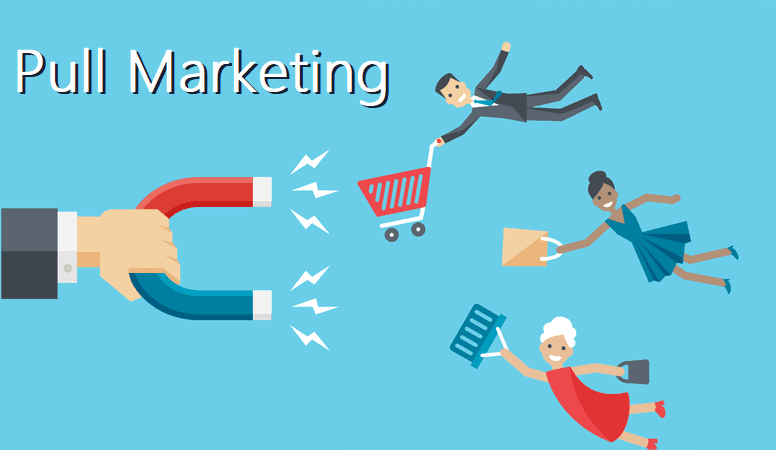
- Tactics: Strategies are designed to pull customers towards your products and services. This involves creating interest and demand so that customers seek out your offerings.
- Approach: Utilizes more subtle strategies, such as content marketing, social media engagement, and SEO, to naturally attract customers over time.
- Goals: Aim at long-term goals and build customer loyalty, emphasizing relationship building and sustaining the brand.
Push Marketing:
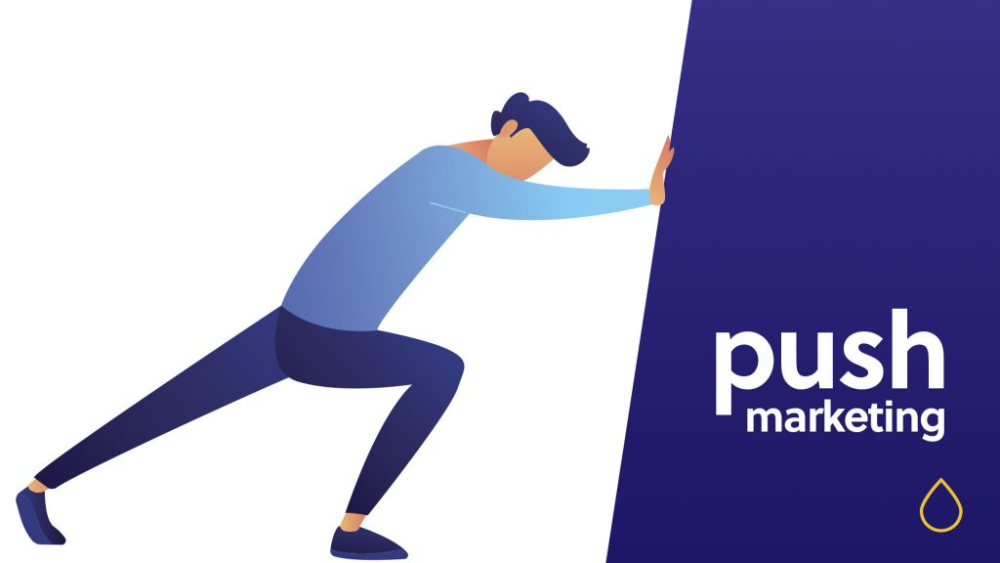
- Tactics: Strategies are employed to push your products and services to customers. This often involves direct promotion and advertising methods to get the product in front of potential buyers,
- Approach: Typically involves aggressive approaches, such as sales promotions through online ads, direct mail, and cold calls, to actively reach out to customers.
- Goals: Focused on short-term objectives and immediate sales, aiming for quick conversations and immediate revenue.
When to Push and When to Pull?
Choosing between push and pull marketing depends on your specific goals and the nature of your product or service. There is not a definitive answer for which strategy is better, as both have their advantages and ideal use cases.
When to Utilize Push Marketing
Push marketing is ideal if you have a specialized product or service. By directly addressing customers who are likely to be interested, you increase the likelihood of interaction and conversion. However, push marketing is less effective if your goal is merely engagement or awareness because it’s highly specific. The targeted nature of push marketing tends to result in higher conversion rates among those who do interact.
When to Utilize Pull Marketing
Pull marketing works well if you have a new brand or if your business is in the early stages of growth. This broad strategy aims to increase brand awareness and boost your reputation. This marketing strategy generally leads to higher engagement levels, though conversions to sales may be lower compared to push marketing. It’s effective for building a larger audience and fostering brand loyalty.
When to Utilize Both Marketing Strategies
Many marketers have found that a combination of push and pull marketing tends to work best, especially in industries such as B2B marketing. By using both strategies, you can be visible and available without limiting your market. For instance, in B2B marketing, you might use pull marketing boosted by SEO to create general awareness and complement it with promotional emails to address specific needs at the right time.
Ultimately, the choice between push and pull marketing should align with your marketing objectives, target audience, and the unique aspects of your product or service. If you ask us, we would suggest that you try multi-channel marketing for the best results.
Conclusion
Both pull and push marketing strategies are valuable in a marketer’s toolkit. Pull marketing focuses on building brand awareness and gaining the trust of potential customers through informative content. On the other hand, push marketing directly promotes products and services to influence buying decisions and generate leads. Often, the best approach involves using a combination of both strategies. Businesses can use pull marketing to establish brand loyalty and then utilize push marketing for targeted promotions and conversions. By understanding your ideal customer and aligning your marketing efforts with your advertising goals, you can attract customers and achieve long-term success.
Frequently Asked Questions (FAQs)
What is pull marketing?
Ans. Pull or inbound marketing is like a magnet. It attracts customers to your business through valuable content and experiences.
What is push marketing?
Ans. This marketing strategy actively promotes your product or service to potential customers. It’s like showing eye-catching ads and pushing products towards customers.
When should I use pull marketing?
Ans. This marketing strategy is good for new brands or if you want to build brand awareness. It’s great for attracting a larger audience and building long-term relationships.
When should I use push marketing?
Ans. Push marketing is ideal for promoting specific products or services, especially if you have a well-defined target audience. It’s good for short-term goals and driving quick sales.
Can I use both pull and push marketing together?
Ans. Yes! Many businesses find a combination that works best. You can make your brand visible with pull marketing and target specific audiences with push marketing.

